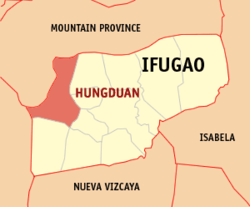Hungduan | |
|---|---|
| Municipality of Hungduan | |
 Hapao Rice Terraces in Hungduan | |
 Map of Ifugao with Hungduan highlighted | |
Location within the Philippines | |
| Coordinates: 16°50′N121°00′E / 16.83°N 121°E | |
| Country | Philippines |
| Region | Cordillera Administrative Region |
| Province | Ifugao |
| District | Lone district |
| Barangays | 9 (see Barangays) |
| Government | |
| • Type | Sangguniang Bayan |
| • Mayor | Casan P. Dumulag |
| • Vice Mayor | Romeo L. Haguyayap |
| • Representative | Solomon R. Chungalao |
| • Municipal Council | Members |
| • Electorate | 6,223 voters (2025) |
| Area | |
• Total | 260.30 km2 (100.50 sq mi) |
| Elevation | 1,291 m (4,236 ft) |
| Highest elevation | 2,604 m (8,543 ft) |
| Lowest elevation | 651 m (2,136 ft) |
| Population (2024 census) [3] | |
• Total | 8,970 |
| • Density | 34.5/km2 (89.3/sq mi) |
| • Households | 1,983 |
| Economy | |
| • Income class | 4th municipal income class |
| • Poverty incidence | 4.08 |
| • Revenue | ₱ 157.8 million (2022) |
| • Assets | ₱ 172.2 million (2022) |
| • Expenditure | ₱ 139.2 million (2022) |
| • Liabilities | ₱ 25.88 million (2022) |
| Service provider | |
| • Electricity | Ifugao Electric Cooperative (IFELCO) |
| Time zone | UTC+8 (PST) |
| ZIP code | 3603 |
| PSGC | |
| IDD : area code | +63 (0)74 |
| Native languages | Ifugao Kallahan Tuwali Ilocano Tagalog |
Hungduan, officially the Municipality of Hungduan is a municipality in the province of Ifugao, Philippines. According to the 2024 census, it has a population of 8,970 people. [5]
Contents
- Geography
- Barangays
- Climate
- Demographics
- Economy
- Government
- Local government
- Elected officials
- Education
- Primary and elementary schools
- Secondary schools
- References
- External links
Through Presidential Proclamation 660, October 1, 2024 was declared a special non-working day for the commemoration of its 107th Founding Anniversary. [6]


